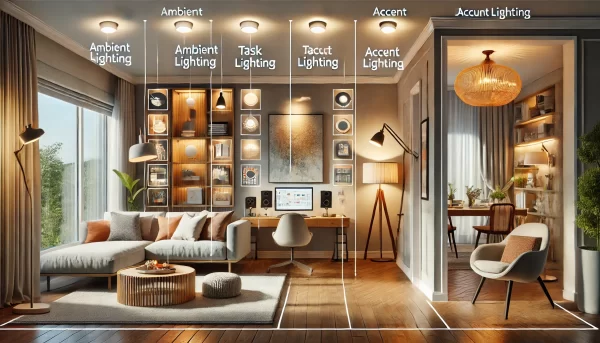
The lighting in your home does more than just brighten your rooms—it defines the atmosphere, enhances functionality, and highlights your style. Choosing the right indoor lighting for each space can make a significant difference in how you experience your home. From practical task lighting to decorative accent lighting, the options are diverse and versatile.
This guide explores the various types of indoor lighting, their uses, and tips for making energy-efficient and stylish choices. Whether you’re planning a complete lighting overhaul or simply looking to upgrade a few fixtures, this article will provide the insights you need.
Understanding the Basics of Indoor Lighting
Indoor lighting can be classified into three primary categories: ambient, task, and accent lighting. Each serves a specific purpose, and a well-lit space often combines all three for maximum functionality and aesthetic appeal.
Ambient Lighting
Ambient lighting forms the foundation of a room’s illumination. It ensures a room is evenly lit, creating a comfortable level of brightness that allows for general activities such as walking, sitting, or socialising.
Fixtures like ceiling-mounted lights, recessed lights, and chandeliers are commonly used for ambient lighting. The tone of the light plays a crucial role—warm lighting creates a cosy atmosphere, while cooler tones are ideal for functional spaces like kitchens and bathrooms. For eco-conscious homeowners, incorporating energy-efficient lighting solutions into your ambient lighting plan can help reduce utility costs while protecting the environment.
Task Lighting
Task lighting is designed to illuminate specific areas where detailed activities occur, such as reading, cooking, or working. Unlike ambient lighting, task lighting is focused and typically brighter to reduce eye strain.
Popular examples include desk lamps, pendant lights over kitchen islands, and under-cabinet lighting. When installing task lighting, consider adjustable options for flexibility and aim to reduce shadows or glare.
Accent Lighting
Accent lighting adds depth and dimension to a space by highlighting particular features, such as artwork, architectural elements, or decorative pieces. This type of lighting is often brighter than ambient light but used sparingly to draw attention to focal points.
Wall-mounted spotlights, track lighting, and LED strips are commonly used for accent lighting. Placement is key—ensure the fixture directs light exactly where it’s needed to create the desired visual impact.
Lighting Solutions for Different Rooms
Each room in your home has unique lighting requirements based on its purpose and layout. Choosing the right combination of lighting types can elevate the functionality and aesthetic of your space.
Living Rooms
The living room is a space for relaxation and socialising, requiring a mix of ambient and accent lighting.
- Ambient: Ceiling fixtures or recessed lights provide general illumination.
- Accent: Wall sconces or LED strips can highlight artwork or decorative features.
- Task: Table lamps are ideal for reading corners or side tables.
Kitchens
Kitchens require bright, focused lighting for safety and efficiency during meal preparation.
- Ambient: Pendant lights or track lights can create an inviting atmosphere.
- Task: Under-cabinet lighting eliminates shadows on countertops.
- Accent: Use strip lighting to showcase cabinetry or glass shelves.
Bedrooms
Bedrooms need a balance of soft, soothing light and practical task lighting.
- Ambient: Warm-toned ceiling fixtures or dimmable lights set a relaxing mood.
- Task: Bedside lamps or wall-mounted reading lights provide focused light.
- Accent: Highlight decorative features with spotlights or LED strips.
Energy-Efficient Indoor Lighting
Sustainability is a key consideration when choosing indoor lighting. Energy-efficient lighting options not only lower electricity bills but also reduce environmental impact.
LED Lighting
LED lights are a popular choice for their long lifespan, low energy consumption, and versatility. Available in a range of colours and brightness levels, LEDs can suit any room and purpose.
Proper installation and maintenance are essential for maximising the benefits of LEDs. Learn more about installing and maintaining LED lights for optimal performance.
Smart Lighting Systems
Smart lighting takes energy efficiency to the next level by allowing users to control brightness, schedules, and even colour temperatures through smartphones or voice-activated devices.
Integrating smart lighting into your home makes it easier to save energy while adding convenience and customisation to your lighting setup. Features like motion sensors ensure lights are used only when needed, further enhancing efficiency.
Creating Ambience with Smart Lighting
Smart lighting isn’t just practical—it’s also a great tool for creating ambience and personalising your spaces.
Mood Settings
Smart systems allow you to pre-set lighting for different scenarios, such as a movie night, dinner party, or relaxing evening. Adjusting brightness and colour tones can transform the atmosphere with minimal effort.
Convenience and Automation
Smart lighting can integrate with home automation systems, enabling seamless control alongside other devices like thermostats or security cameras. This level of convenience enhances the overall home experience.
Maintaining Your Indoor Lighting
Regular upkeep ensures your indoor lighting remains efficient, functional, and visually appealing.
Cleaning Fixtures
Dust and grime can accumulate on light fixtures, reducing their brightness and effectiveness. Periodic cleaning with appropriate tools and products keeps your lighting at its best.
Replacing Bulbs and Fixtures
Switching outdated fixtures with energy-efficient options ensures optimal performance. When replacing bulbs, consider LED alternatives for their superior longevity and cost savings.
Conclusion
Indoor lighting is more than just a functional necessity; it’s a design element that can transform how you experience your home. By understanding the different types of lighting and their uses, you can create a balanced and visually appealing lighting scheme that caters to your needs.
Whether you’re enhancing your home with task lighting, exploring energy-efficient solutions, or integrating smart systems, the possibilities are endless. To ensure the best results, consider expert advice and high-quality products like those offered by Blacktown Electrical.
Upgrade your indoor lighting today and enjoy a brighter, more comfortable home!
